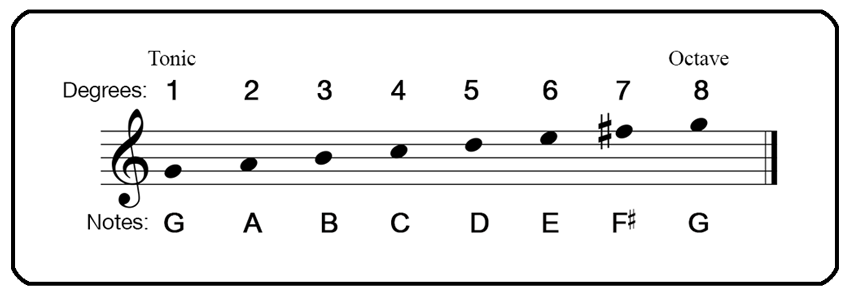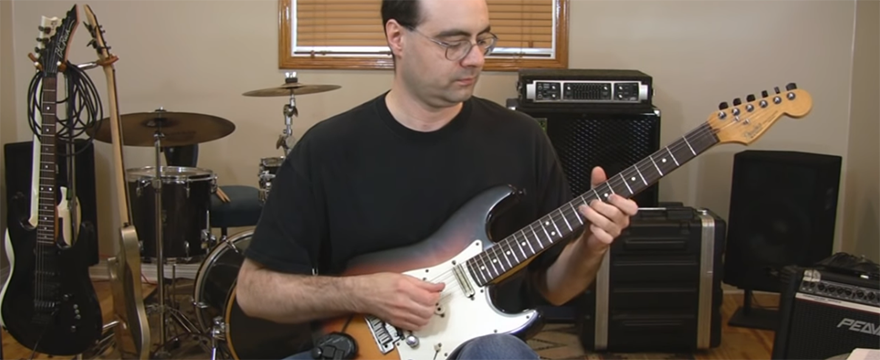If you’re a guitar player who hopes to become a successful improvisor, then you’re in luck because this lesson will open your eyes to five improvising concepts that will help get you there. Learn the importance of focusing on; scales, famous players solos, how to build emotion, performing phrasing techniques, along with developing guitar theory and music theory…
Q: I’m Stuck at Doing Improvisation
“I am totally stuck when it comes to doing improvising. I have spent a lot of time practicing scales and also learning about keys and Music Theory. I have also worked through several books that teach guitar licks all over the fingerboard. I have good technique, I have learned how to play fast lines, tapping, sweep picking, etc. but, I still just cant seem to play a nice long melody during a solo. When I listen to top-notch players like Steve Vai or just good all around guitar players such as David Gilmour they seem to have a flow to their playing that I just cant seem to obtain. Can you please help me with a few tips on this topic.”
Thank you,
Donald – Las Vegas, NV.
A: Developing the skill and ability to effectively improvise well on guitar will take a lot of study and a lot of practice. To help you begin developing these skills, I’m going to suggest that you focus on an improvising practice routine using my tried and true, “Top 5” list of Improvising Concepts.
Top 5 list of Improvising Concepts
1). Learn Scale Patterns and Octave Templates
Practice them for around a half-hour, to an hour, four or five days per week, (for at least 3 weeks). Doing his work will help with gaining a solid level of technique for the scale and octave patterns all over the guitar neck.
Over time, add more scales to the study routine. Include; modes and the Harmonic and Melodic Minor scales. Eventually expand the study routine to include arpeggios for all of the diatonic chord types. NOTE: This is a lot of ground to cover and could take as long as 2 to 3 years to complete.
2). Study the Guitar Solos of Famous Guitarists
Listen, practice and memorize several legendary guitar solos. Study exactly how the solos were performed along and across the neck. Be sure to include guitar solos played by all different types and styles of great guitar players.
Work on every solo with a goal in mind of developing a clear understanding of how each player applies space and economy throughout their solos.
Also, spend time listening to solos on other instruments, as well as, how vocal melody lines are performed. Do a good deal of transcription work with a focus on learning how each note relates back to the key signature. Or, if the note does not relate, learn reasons for why it works in the solo.
3). Feelings and Emotions
Good improvisors understand that when they are performing a solo, their feelings (and also their emotions), play a huge role in developing phrases.
The more feeling that a musician can add to their solo will tend to go a long way to helping capture the listeners attention.
When it comes down to playing guitar solos that have more feeling and more emotion, the big question is…
“How does a guitarist learn to tap into their feelings and emotions?”
It’s a tough question to answer for every guitarist out there, but one way you can start moving in the right direction is to pay attention to when you feel inspired. And, when that happens… PLAY GUITAR!
Over time, your mind will start noticing what it’s like to tap into deeper emotions and more profound feelings. And, when that happens, your sub-conscious will start to become used to focusing those emotions in a purposeful way.
4). Phrasing Devices
Students of improvisation will often develop a narrow focus about playing lead. Usually this narrow focus is based upon the more basic elements of lead guitar.
These basic elements will commonly include topics like the application of scales and the use of simple neck patterns (for their favorite soloing locations). Even though this is normal, soloists cannot forget about phrasing devices.
When it comes to using phrasing tools for soloing a guitarist needs to consider articulations and embellishments upon all of the patterns that they will play. These ideas are referred to as, “Phrasing Devices.”
In order to bring the effect of the note selections up to a new level of interpretation the choice of phrasing devices must always be carefully considered. These devices can include concepts and techniques such as;
- slides
- bends
- legato
- vibrato
- double-stops
- harmonics
- pull-offs
- hammer-ons
- slurs
- grace notes
- scratch (ghost) notes
5). Scale Degrees and Chord Tones
Once a musician learns how to comprehend the use of scale degrees and chord tones it will become one of their most effective methods for being able to perform the best sounding notes during a guitar solo.
SCALE DEGREES:
The degrees of a scale refer to the numeric step given to each note in a scale. For example the first note in the key of “G” would be the scales tonic note. Tonic notes are indicated as degree “1.”
The last note of a key is the 7th note. In the key of “G” the seventh note is the note of “F#.” The next occurrence of the scales tonic, (in a higher register), is considered as the “Octave,” (often notated as “8”).
Study the image below. It demonstrates the note names, as well as, each notes degree within the key of “G” Major.

CHORD TONES:
Chord tones refer to the notes that exist within a chord. When a chord is constructed, the specific tones that are used in its construction are taken from the 1st, 3rd and 5th degrees of the scale (1, 3, 5). These tones create a chord type that would be referred to as a, “triad.”
Every musical key can have a chord constructed from off of each degree. By traveling from an established root note in the key, we achieve chord tones by moving off the established root, up a 3rd and then again to the 5th.
If we apply the 1, 3, 5 formula off of each of the chord roots in a key, we end up with every one of the tones of each of the chords. For example, in the key of “G” (from the first chord’s root of “G”), we get, “G, B, D.”
The second chord in the key of “G” begins on the note of “A.” It’s tones would again travel in the 1, 3, 5 process giving us; “A, C, E.” Look at the image below. It demonstrates how this “1, 3, 5” process can be applied off of every step of the key of “G,” giving us all of the chords, (and their 1, 3, 5 tones), for every step of the key.

Targeting into chord tones will require that a student to develop a good working knowledge of which notes specifically exist inside of a chord that is being performed at any moment.
Being highly capable at targeting chord tones is not an easy skill to master for a musician. However, with a practice routine it can be attained. For details on this subject, watch my YouTube lesson on the value of practicing chord tones using a 30 day routine.
BONUS
Guitar Theory and Music Theory
One final point that I believe is also important to understand when it comes to improvising concepts is comprehending the difference between, “Guitar Theory,” and “Music Theory.”
GUITAR THEORY:
The study of how scale degrees, arpeggio degrees and the tones of chord patterns form different kinds of geometrical shapes on the fingerboard is generally referred to as, “Guitar Theory.”
The shapes and patterns of every musical interval that we learn will relate to specific chord qualities. This relationship will tie into various musical tonalities. The way that we learn to use every sound generated by these shapes will affect how we play music on guitar.
MUSIC THEORY:
The technical study of how musical keys interact across melody and harmony to create musical concepts is the topic of Music Theory.
There are methods and standards of practice that are used to comprehend musical elements across any piece of music.
Once these factors are well understood, a musician will have both the mental awareness and the logical control to be able to better perform and better utilize musical direction on their instrument.
As a practicing musician, it is important to study Music Theory and to learn how to use it in a way that will help develop the skills necessary for targeting specific notes and chords as you compose or perform songs.
Music theory can be a complex topic to master, and it will take awhile to learn how to comprehend every area of music theory at high levels.
Even though it takes a lot of time and effort to learn and master music theory, it is an excellent subject to know well – making it worth all of the time and the effort that musicians will need to invest.
Once you begin to see the results that theory provides, (along with the possibilities its knowledge can offer), the benefits will be quick to follow.
